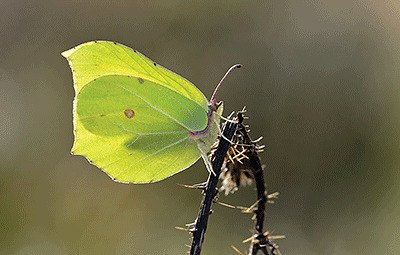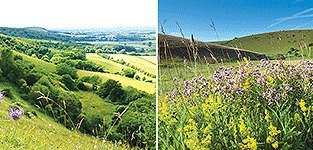Sussex Wildlife Trust: Brimstone butterfly
March 1st, 2021 This claim may be a myth and it’s also untrue that these March Brimstones are the first signs of the year’s new life.
This claim may be a myth and it’s also untrue that these March Brimstones are the first signs of the year’s new life.Brimstone butterfly
This winter lockdown has certainly felt harder because of the winter. Don’t get me wrong, I’ve enjoyed the bleak beauty of winter: bare trees, frosted landscapes. But now I need something to get my heart racing. I need a sign – some hope in these challenging times, a promise of those dynamic spring months ahead, a flash of colour. In March my light at the end of the tunnel is an oncoming butterfly.
On sculpted, vibrant yellow wings the Brimstone butterfly makes his elegant entrance into the New Year on those bright March days when you feel the warmth of the sun on your face.
Its distinctive yellow wings have given birth to a legend – that this ‘butter-coloured fly’ was the inspiration for the word butterfly.
This claim may be a myth and it’s also untrue that these March Brimstones are the first signs of the year’s new life.
By the time Brimstones appear in March they are already on their last (six) legs. Fresh Brimstone butterflies emerged from their chrysalises in late summer, so by February they could be seven months old – and in butterfly years that’s ancient.
Admittedly almost all of that time they’ve been asleep in a hedge, sheltered from the storms under Holly and Ivy.
Yet despite the worst winter weather they always emerge immaculate in the spring. They must be made of Teflon.
When they awake the (bright yellow) males search for a mate, they mate, the (pale yellow) females lay eggs and then both die. Still, an adult life of over ten months earns them the title of our longest-lived butterfly. An insect OAP.
My first Brimstone sighting each year doesn’t exactly mean that spring is starting but it’s certainly a sign that winter is starting to end. And, after the tough winter that we’ve all just suffered, that’s good enough for me.
Either way this beautiful yellow butterfly is a welcome messenger of what’s to come – the first sulphurous spark to ignite the blaze of spring.
Let’s hope that with the spring comes hope for a brighter for us all.
Sussex Wildlife Trust have started working with Horsham District Council on an innovative five-year partnership project called Wilder Horsham District.
We’ll be working closely with local communities and landowners to reverse the decline in species and habitats and enrich the natural environment for all residents and visitors.
I’ll keep you updated with opportunities for you to get involved and help the wildlife around Steyning.
https://sussexwildlifetrust.org.uk/wilderhorshamdistrict
By Michael Blencowe: Learning & Engagement Officer, Sussex Wildlife Trust
Sussex Wildlife Trust is an independent registered charity caring for wildlife and habitats throughout Sussex. Founded in 1961, we rely on the support of our members to help protect our rich natural heritage. Please consider supporting our work. As a member you will be invited to join Michael Blencowe on our regular wildlife walks and also enjoy free events, discounts on wildlife courses, Wildlife magazine and our guide book: Discovering Wildlife in Sussex.
It’s easy to join online at:www.sussexwildlifetrust.org.uk/join or T: 01273 497532.
Brimstone by Bob Eade Sussex Wildlife Trust.
This winter lockdown has certainly felt harder because of the winter. Don’t get me wrong, I’ve enjoyed the bleak beauty of winter: bare trees, frosted landscapes. But now I need something to get my heart racing. I need a sign – some hope in these challenging times, a promise of those dynamic spring months ahead, a flash of colour. In March my light at the end of the tunnel is an oncoming butterfly.
On sculpted, vibrant yellow wings the Brimstone butterfly makes his elegant entrance into the New Year on those bright March days when you feel the warmth of the sun on your face.
Its distinctive yellow wings have given birth to a legend – that this ‘butter-coloured fly’ was the inspiration for the word butterfly.
This claim may be a myth and it’s also untrue that these March Brimstones are the first signs of the year’s new life.
By the time Brimstones appear in March they are already on their last (six) legs. Fresh Brimstone butterflies emerged from their chrysalises in late summer, so by February they could be seven months old – and in butterfly years that’s ancient.
Admittedly almost all of that time they’ve been asleep in a hedge, sheltered from the storms under Holly and Ivy.
Yet despite the worst winter weather they always emerge immaculate in the spring. They must be made of Teflon.
When they awake the (bright yellow) males search for a mate, they mate, the (pale yellow) females lay eggs and then both die. Still, an adult life of over ten months earns them the title of our longest-lived butterfly. An insect OAP.
My first Brimstone sighting each year doesn’t exactly mean that spring is starting but it’s certainly a sign that winter is starting to end. And, after the tough winter that we’ve all just suffered, that’s good enough for me.
Either way this beautiful yellow butterfly is a welcome messenger of what’s to come – the first sulphurous spark to ignite the blaze of spring.
Let’s hope that with the spring comes hope for a brighter for us all.
Sussex Wildlife Trust have started working with Horsham District Council on an innovative five-year partnership project called Wilder Horsham District.
We’ll be working closely with local communities and landowners to reverse the decline in species and habitats and enrich the natural environment for all residents and visitors.
I’ll keep you updated with opportunities for you to get involved and help the wildlife around Steyning.
https://sussexwildlifetrust.org.uk/wilderhorshamdistrict
By Michael Blencowe: Learning & Engagement Officer, Sussex Wildlife Trust
Sussex Wildlife Trust is an independent registered charity caring for wildlife and habitats throughout Sussex. Founded in 1961, we rely on the support of our members to help protect our rich natural heritage. Please consider supporting our work. As a member you will be invited to join Michael Blencowe on our regular wildlife walks and also enjoy free events, discounts on wildlife courses, Wildlife magazine and our guide book: Discovering Wildlife in Sussex.
It’s easy to join online at:www.sussexwildlifetrust.org.uk/join or T: 01273 497532.
Brimstone by Bob Eade Sussex Wildlife Trust.
Comments (0)
No comments have been submitted yet.Why not be the first to send us your thoughts
Leave A Comment
Thank you for your comments, they will appear shortly once approved.
Recent Posts
Have You Seen...






